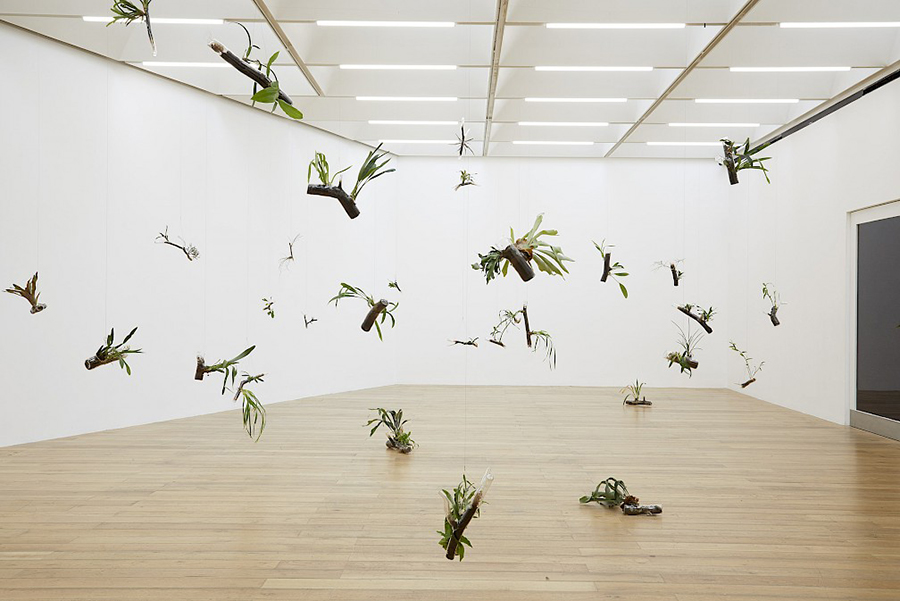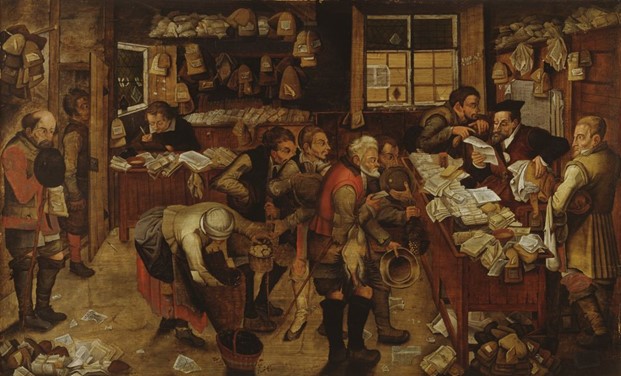The Center supports long-term and short-term research initiatives designed to contribute to the wider scholarly community. Deans’ research projects are long-term projects directed by a dean. Short-term research initiatives promote collaboration and innovation.
Deans’ Research Projects
The Arts and Thinking With

Daniel Steegmann Mangrané, Living Thoughts, 2019, glass and epiphytic plants, dimensions variable. Photo courtesy the artist
Associate dean Kaira M. Cabañas has initiated The Arts and Thinking With as an iterative research platform that serves as a conceptual frame and road map. It encourages thinking with art and the issues it shapes through material and imaginative expressions. In the spirit of continuous learning, each iteration opens onto various issues and multiple histories. Potential research processes and outcomes include Center guest dialogues, research seminars, panel discussions, and publications. In 2023–2027 the research initiative will consider the arts in mental health.
2023–2027: The Arts in Mental Health
For 2023–2027 “The Arts in Mental Health” considers the intertwined histories of art and creative therapies. It will address the work of notable modern artists, from Camille Claudel to Vincent Van Gogh, and delve into the work of contemporary artists such as Yayoi Kusama and Javier Téllez. As part of this research initiative, and in collaboration with the Museu de Arte de São Paulo (MASP), associate dean Kaira M. Cabañas will conceive and co-organize a multipart seminar series on “Histories of Madness,” exploring the history of psychiatry and the role of art within it.
The first Center/MASP seminar will take place virtually 2025.
Kaira M. Cabañas, Associate Dean for Academic Programs and Publications
Sarah Battle, Associate Projects Manager, Academic Programs and Publications
Molly Superfine, Postdoctoral Research Associate
The Early History of the Accademia di San Luca, c. 1590–1635

Pieter Brueghel the Younger, Village Lawyer, 1621, oil on panel, Museum voor Schone Kunsten Gent, 1952-G
The Early History of the Accademia di San Luca was conceived, under the direction of associate dean Peter M. Lukehart, as a project in two parts: a volume of essays concerning the establishment of one of the first artists’ academies in late 16th-century Italy and a database of newly rediscovered notarial documents that support current and future study of the Accademia and its members. The database of documents, The History of the Accademia di San Luca, c. 1590–1635: Documents from the Archivio di Stato di Roma, encourages new research on the Accademia. Maps and guidebooks presented on the website contextualize the primary material with nuanced historical information about locations where the Accademia conducted business. Documents, essays, bibliographies, and image collections offer myriad ways to learn and explore. Anticipating a redesign in the near future, the web team is preparing to archive and migrate the research project to a new online home.
Published to the project website in September 2023, two essays written by Laurie Nussdorfer and Antonia Fiori contextualize the role of notaries and legal systems in early modern Rome, particularly for artists affiliated with the Accademia di San Luca. This same month, the project team hosted a webinar, “Artists, Notaries, and Legal Obligations in Early Modern Rome,” with keynote presentations from Nussdorfer and Fiori. This was followed by responses from Renata Ago, Elizabeth Cohen, Thomas Cohen, and Laura Morreale, who focused on the use of notarial documents in their fields and how the two essays on Roman notaries and the cameral obligation might affect their research going forward.
In October 2023, the project team presented “Digital Itineraries in Rome: Annotating Early Modern Guidebooks for the History of the Accademia di San Luca, c. 1590–1635” at the Sixteenth Century Society annual conference in Baltimore. Focusing on research with historical guidebooks, the presentation explored two case studies: the Palazzo Altemps in Montecavallo and the Church of Santi Luca e Martina in the Roman Forum.
Matthew J. Westerby and Fulvia Zaninelli drafted an essay for the forthcoming issue of Facture, also written with Kimberly Schenck, head of paper conservation and senior conservator at the National Gallery of Art. Their paper explores the materials and stages of production of an early 17th-century drawing at the National Gallery, traced after an engraving by Francesco Villamena, member of the Accademia di San Luca.
Peter M. Lukehart, Associate Dean for Fellowships and Fellows Programs
Matthew J. Westerby, Digital Research Officer
Fulvia Zaninelli, Senior Postdoctoral Research Associate
Reimagining the Index of American Design

Moses Bank, Wall Paper, 1934, watercolor, gouache, and graphite on paperboard, Index of American Design, 1943.8.16032
The Index of American Design (IAD) opens opportunities to explore the unique history of American design and invites reflections on topics of national, regional, and local identity. Over the last year, the research team developed short-term and long-term plans—in coordination with National Gallery partners in content strategy, digital experience, digital solutions, archives, and curatorial departments—to create an immersive presence for the IAD on the National Gallery’s website. This new online home will engage the imagination of our audiences, integrate perspectives outside of academic art worlds into research and interpretation, and strengthen the National Gallery’s impact as a national museum in service to communities across the country. Center research associates and Howard University interns have explored the collection by region and state. This work has opened up new questions about the scope and definition of the IAD as it was originally conceived.
Steven Nelson, Dean
Amaya Charley, Howard University Undergraduate Intern
Gloria de Liberali, Postdoctoral Research Associate
Kennedy Martin, Howard University Undergraduate Intern
Miles Kenyan Stewart, Howard University Undergraduate Intern
Matthew J. Westerby, Digital Research Officer
Short-Term Research Initiatives
Mapping Our Museum

Agnes Denes, Map Projections: The Snail I, 1976, four-color lithograph on Rives BFK paper, Gift of Charles J. Tanenbaum and Ailsa Mellon Bruce Fund, 2003.65.5
Mapping Our Museum features teams of staff, fellows, and interns from across the National Gallery collaborating on research questions through maps and visualizations. Guest presentations this past year showcased critical approaches and conceptual frameworks to mapping and visualization in the digital humanities and digital art history. In October 2023, Dorothy Berry led a facilitated conversation titled “Who Makes the Rules” on how and why digital description matters. In November, Susan Elizabeth Gagliardi and Constantine Petridis presented “Mapping Senufo: Art, Evidence, and Uncertainty.” Mapping Our Museum workshops offer introductions to data curation and digital tools and are open to all National Gallery staff. GIS consultant Jean Aroom led a virtual workshop on “Elements of GIS” in January 2024.
Matthew J. Westerby, Digital Research Officer
